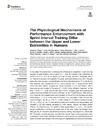Identificador persistente para citar o vincular este elemento:
https://accedacris.ulpgc.es/jspui/handle/10553/41967
| Título: | The physiological mechanisms of performance enhancement with sprint interval training differ between the upper and lower extremities in humans | Autores/as: | Zinner, Christoph Morales Alamo, David Ørtenblad, Niels Larsen, Filip J. Schiffer, Tomas A. Willis, Sarah J. Gelabert-Rebato, Miriam Pérez Valera, Mario Boushel, Robert Calbet, Jose A. L. Holmberg, Hans-Christer |
Clasificación UNESCO: | 241106 Fisiología del ejercicio | Palabras clave: | High-intensity training Lower body Performance Triceps brachii Upper body |
Fecha de publicación: | 2016 | Publicación seriada: | Frontiers in Physiology | Resumen: | To elucidate the mechanisms underlying the differences in adaptation of arm and leg muscles to sprint training, over a period of 11 days 16 untrained men performed six sessions of 4-6 × 30-s all-out sprints (SIT) with the legs and arms, separately, with a 1-h interval of recovery. Limb-specific VO2peak, sprint performance (two 30-s Wingate tests with 4-min recovery), muscle efficiency and time-trial performance (TT, 5-min all-out) were assessed and biopsies from the m. vastus lateralis and m. triceps brachii taken before and after training. VO2peak and Wmax increased 3-11% after training, with a more pronounced change in the arms (P < 0.05). Gross efficiency improved for the arms (+8.8%, P < 0.05), but not the legs (-0.6%). Wingate peak and mean power outputs improved similarly for the arms and legs, as did TT performance. After training, VO2 during the two Wingate tests was increased by 52 and 6% for the arms and legs, respectively (P < 0.001). In the case of the arms, VO2 was higher during the first than second Wingate test (64 vs. 44%, P < 0.05). During the TT, relative exercise intensity, HR, VO2, VCO2, VE, and Vt were all lower during arm-cranking than leg-pedaling, and oxidation of fat was minimal, remaining so after training. Despite the higher relative intensity, fat oxidation was 70% greater during leg-pedaling (P = 0.017). The aerobic energy contribution in the legs was larger than for the arms during the Wingate tests, although VO2 for the arms was enhanced more by training, reducing the O2 deficit after SIT. The levels of muscle glycogen, as well as the myosin heavy chain composition were unchanged in both cases, while the activities of 3-hydroxyacyl-CoA-dehydrogenase and citrate synthase were elevated only in the legs and capillarization enhanced in both limbs. Multiple regression analysis demonstrated that the variables that predict TT performance differ for the arms and legs. The primary mechanism of adaptation to SIT by both the arms and legs is enhancement of aerobic energy production. However, with their higher proportion of fast muscle fibers, the arms exhibit greater plasticity. | URI: | https://accedacris.ulpgc.es/handle/10553/41967 | ISSN: | 1664-042X | DOI: | 10.3389/fphys.2016.00426 | Fuente: | Frontiers In Physiology [ISSN 1664-042X], v. 7 |
| Colección: | Artículos |
Citas SCOPUSTM
69
actualizado el 08-jun-2025
Citas de WEB OF SCIENCETM
Citations
64
actualizado el 08-jun-2025
Visitas
96
actualizado el 20-abr-2024
Descargas
94
actualizado el 20-abr-2024
Google ScholarTM
Verifica
Altmetric
Comparte
Exporta metadatos
Los elementos en ULPGC accedaCRIS están protegidos por derechos de autor con todos los derechos reservados, a menos que se indique lo contrario.
